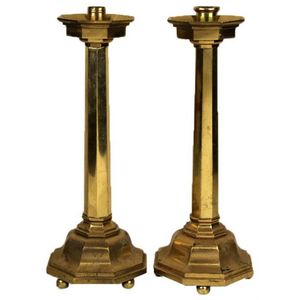Alabaster Cupid and Psyche on Column Base
An early 20th century carved alabaster figure of cupid with Psyche set on a column base. Provenance: Purchased from Bazmark Film III - Great Gatsby Prop Sale restored, wings in office
You must be a subscriber, and be logged in to view price and dealer details.
Subscribe Now to view actual auction price for this item
When you subscribe, you have the option of setting the currency in which to display prices to $Au, $US, $NZ or Stg.
This item has been sold, and the description, image and price are for reference purposes only.
- Cupid Motif - The Cupid motif, which features the Roman god of love and desire, Cupid, was a popular decorative element in classical ornamentation. Cupid was often depicted as a winged, naked baby with a bow and arrow, and was often used to symbolize love and desire.
In classical art and architecture, Cupid motifs were often used as decorative elements on furniture, such as on the legs of chairs and tables, as well as on architectural elements such as friezes and pediments. They were also used as decorative elements in frescoes, mosaics, and other forms of art.
During the Renaissance, Cupid motifs were often incorporated into the decoration of palaces, churches and other grand buildings, as they were seen as symbols of love and fertility. Cupid motifs were also commonly used in the decorative arts of the Baroque period, often appearing in the form of putti, which are small winged cherub figures.
In addition to their decorative use, Cupid motifs were also believed to hold symbolic meaning, as they were thought to evoke feelings of love, desire, and fertility. - Alabaster - Alabaster is soft natural stone used for statuary, with a similar appearance to marble, but easier to work with. As it is softer than marble, an item made from alabaster can be scratched with a metal object, and an alabaster item does not polish to a high surface gloss like marble.
Alabaster objects can be semi-translucent. Alabaster occurs in a pure white form and also with veining from dirt. Colours vary from white through yellow and pink to brown. The veining is usually green or black but can be multicoloured.
Being semi-translucent, alabaster is often used for the bowls of figural lamps, with the figure itself being either alabaster or marble.
This item has been included into following indexes:
Visually similar items

19th century Sienna marble column pedestal
Sold by
in
for
You can display prices in $Au, $US, $NZ or Stg.

Beard Watson pedestal stand 35 cm x 35 cm, 120 cm high
Sold by
in
for
You can display prices in $Au, $US, $NZ or Stg.

Impressive late 19th century carerra marble column of exceptional quality.
Sold by
in
for
You can display prices in $Au, $US, $NZ or Stg.

Brass heavy gauge pair of candlesticks of octagonal form. Height 37 cm
Sold by
in
for
You can display prices in $Au, $US, $NZ or Stg.
